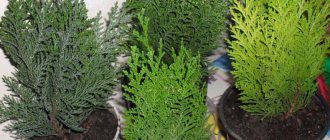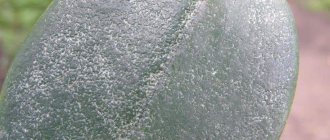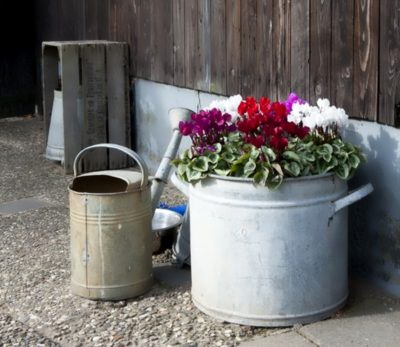
Cyclamen is a perennial plant from the Primrose family. For home cultivation, 2 types are suitable: Persian and European cyclamen (or alpine violet). All types of cyclamen are distinguished by amazingly beautiful buds and a long flowering period.
The plant is unpretentious in care, but novice flower growers may have problems with watering. How to understand that the plant has been flooded? What to do in such a situation?
Growth features
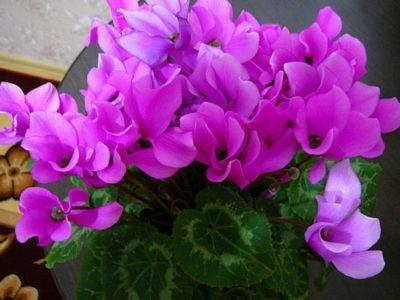

Cyclamen can be grown from seeds only with strict adherence to technology. The container with the planting material must be covered with cellophane (pre-make holes in it for air intake) and put in a warm place. The first shoots will appear in 25-30 days. Some varieties have a longer germination capacity - the shoots of the Kiss and Apple species will appear only after 5-6 months.
The appearance of the first shoots is a sign that the plant needs to be moved to a cooler place. Further, a tuber grows from each bore, a shoot with the first leaf is formed from it. The growth of young seedlings occurs imperceptibly, as they actively build up the root system (the growth of greenery above the surface is temporarily suspended). It is necessary to transplant cyclamen into a permanent pot after the appearance of 2-3 leaves... Subject to all the rules, this occurs 90 days after the appearance of the first shoots.
Diseases
Possible cyclamen diseases can be conditionally divided into parasitic and nonparasitic. In the first case, we are talking about the harm of parasites, in the second - about improper care of the flower. The causes of nonparasitic diseases are:
- excessively moist soil;
- insufficiently humid air in the room where the plant is located;
- wrong choice of soil;
- unsuitable pot;
- the wrong choice of the location of the plant in the house.
As for diseases of a parasitic nature, it is worth mentioning such pests as aphids, cyclamen ticks and thrips.
- Cyclamen mite is microscopic in size, which makes it difficult to see on a flower. It parasitizes on the inside of the leaf. From the outside, it may seem that the leaves are covered with dust. When trying to shake off such "dust" difficulties arise, while the edges of the leaves begin to curl. You can get rid of the parasite with the help of chemical antiseptics.
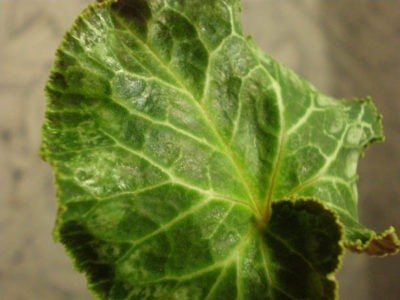

Thrips are highly active. They are very bright and can be easily identified by their silvery bloom. This adversely affects the further growth of the flower leaves. As a result, they may simply fall off. To eliminate thrips, you can use insecticides or sticky tapes.- Aphid is the most common parasite. Its appearance causes a complete deformation of the leaves and the plant itself, contributing to its depletion and taking away all the juices from it. Symptoms of aphid infestation are gray, black, white, orange, or green bloom on the leaves of the flower. To eliminate aphids, spray the cyclamen with an insecticide, and then rinse with running water.
You can read more about cyclamen diseases here, and we wrote about pests that can attack your plant in this article.
Causes of death: why does the plant disappear?
The main factors of plant death are associated with improper care or attack by pests. In the list of common reasons, experts identify the following:
- Improper watering... Water should not get on the tubers and leaves; it is better to pour it at the edge of the pot. A sign of waterlogging of the soil or ingress of water on the tubers - the leaves and flowers of cyclamen begin to wither (read here how to save a flooded cyclamen from waterlogging).
- Excess mineral fertilizers... If there is a large amount of salt or manure in the soil, this leads to rotting of the bush.
- Bright sunlight or dry, hot indoor air... Sign - diseased leaves with large and strong inflorescences.
- Freezing parts of the bush... The problem appears if the pot is on a cold windowsill or on a balcony.
- Insect infestation... Small holes appear on the leaves, the leaf is deformed. Aphids, mites or thrips can appear on the cyclamen.
Is it possible to save?
Cyclamen can be saved only at an early stage in the development of a certain disease (when irreversible changes have not yet occurred with the plant). To provide quality assistance, you need to accurately determine the cause and quickly eliminate it.
TIP: The grower may need a new pot and potting soil for replanting, peat and pebbles, chemicals to eliminate pests. The main condition for proper recovery is providing quality care.
How to reanimate at home: detailed instructions


A universal and general flower restoration program - revision and improvement of flower care. A serious problem and the cause of many diseases is improper watering.
Cyclamen loves moisture, but does not tolerate waterlogging... Water should not touch delicate tubers; it must be poured strictly along the edge of the pot. To increase the air humidity, a tray with peat or wet pebbles can be placed next to the cyclamen.
What to do if the leaves wither - an algorithm of actions
The solution to the situation is a transplant. Salvation in such a situation depends on how rotten the root is. The contents of the pot must be carefully removed. If there are rotten parts on the root, they must be removed. To do this, you need to take a sharp knife, cut off the damaged element to a healthy place, treat the cut site with a weak Previkur solution (1 drop per 2 tablespoons of water). Wait until it dries and transplant the plant into new soil.
If the cyclamen turns yellow and loses leaves, urgent treatment is needed until it dies:
- Inspection of the aerial part, removal of affected tissues (only healthy parts need to be left). Places of cuts must be processed. To do this, you can take a weak solution of Previkur or other disinfectants - a strong solution of potassium permanganate, brilliant green, charcoal powder.
- We take out the tuber. We process it (the action plan is identical to point 1).
- We keep the cyclamen for 24-48 hours in a dry, warm and ventilated room - this stops the decay processes.
- We calcine the soil for transplanting a flower - disinfect it. Heat treatment or freezing is most often used. Ready-made soil mixes are sold already disinfected.
- We plant the plant in a new pot. We put it in a dark place for 1-3 days, water it moderately. If yellowing and rotting is not observed, place the cyclamen in its usual place.
For details on how to save cyclamen from wilting, read here, and from this article you will learn about why the leaves of the plant curl and what to do about it.
How to revive a bush after pests?


How to effectively control pests? Insecticidal soap is suitable for the fight against any insects.... This means you need to rinse the leaves. Against aphids and ticks, 40-50 g is enough for 2-4 liters of water. Dissolve the product in warm water and treat the surface of the sheet.
Additional drugs - Fitoverm and Agravertin. Their feature is the absence of a pungent pungent odor (safe for home use). Dosage Fitoverma - 2 ml per 0.2 l of water in the fight against aphids; 4 ml per 0.5 l of water - thrips. Spray at intervals of 7 days. Repeat no more than 2 times.
The dosage of Agravertine for the fight against any pests (mites, all types of aphids, thrips) is 0.5 liters of water per 1 ampoule in 5 ml. If necessary, repeat spraying after 2 days.
Why does the problem occur and how can I fix it?
Leaves dry
Cyclamen leaves wither for various reasons. This is not always a cause for excitement - you just need to carefully observe the flower. If the plant slowly withers and turns yellow, gradually getting rid of old leaves, then it is time for a seasonal rest. In this case, there are no health problems. If the branches of a flower become bare in a matter of days, then the plant is sick.
A possible cause could be parasite infestation or improper care. In this case, do not despair. It is necessary to start timely treatment that will give a positive result.
Inflorescences wither
If you purchased a flower and it was healthy at the time of purchase, several factors can cause wilting:
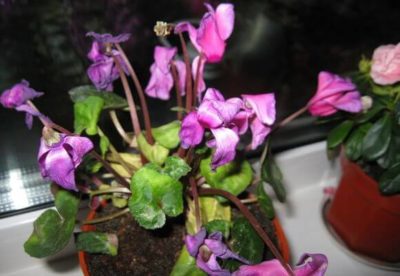

The plant is stressed due to changes in temperature and humidity.- Exhaustion. In stores, often to increase flowering and accelerate growth, flowers are fertilized with powerful stimulants and hormonal drugs.
Preventive measures or how to properly care?
Cyclamen is a capricious and demanding plant; care for it must be of high quality and timely. What is important to know a florist?
- Maintain the temperature... Suitable indicators are 12-15 degrees. It is forbidden to lower the temperature to +10 or increase over 20 degrees.
- Lighting control... The plant does not tolerate direct sunlight, but requires good lighting. The cyclamen pot must be shaded.
- Watering correctly... Water should not touch delicate foliage or tubers.
- We apply top dressing only if the cyclamen quickly fades... It is allowed to add rotted compost (1:10 soil) or 1-2 tbsp into the soil. l. mineral salts. You can also feed young cyclamens.
In order to prevent Once a month, you need to water the plant with a weak solution of Fitosporin, Fundozol, Gamair or Alirin B (see the dosage on the package). These drugs will make the cyclamen stronger, strengthen its protective properties and leave no chance for pests.
Video: Purchased cyclamen, salvation!
Cyclamen, like other plants, has a number of its own care preferences in order to feel as comfortable as possible and delight you with annual health and beauty. Do not forget about this and you should perform them flawlessly, otherwise your plant will be ill.
This plant is best placed in those rooms where it is possible to maintain a room temperature level slightly below average (even 10 to 20 degrees is ideal). The plant does not like direct rays, it needs to be created under conditions of abundant, but diffused light. You may be able to shade the place where the cyclamen will be located, or initially plan it and place it where it will not be exposed to active sunlight and, of course, heating devices. He loves watering above average, but he just loves feeding. Based on these rules, you will understand where and what the cyclamen is missing, and why it began to hurt.
It is noted that the most common reason why cyclamen dies is improper watering. Although he loves abundant watering, oversaturation with moisture is detrimental to him as much as a lack of water. Also, if the plant is visibly withering, perhaps you were watering it incorrectly - in the wrong pattern? In no case should you fill the middle of the flowers, pour into the tuber. Watering should always be carried out along the edge of the pot and nothing else. You can not bother too much and just periodically lower the pot in a container of water for half an hour. This irrigation system is called the pot dip method. this time and water will be enough for the cyclamen to get saturated with moisture. Thus, the flower will maintain its normal state.An indicator that it was you who watered the flower incorrectly - the leaves and stems began to wither, fall, become lethargic, or began to rot. So, you watered the tuber itself with water.
Growth features
Growing cyclamen from seeds will be crowned with success only with strict adherence to the sowing technology:
- seeds are placed in fertile soil;
- the container is covered with glass or film to create a greenhouse effect;
- every day the covering material is lifted up for ventilation.
As soon as shoots have appeared, the plant is transferred to a cool place with a temperature of + 14-16 degrees... At first, a tuber will form from the bore. Only then the first leaf on a thin shoot will grow from it. At first, the plant grows very slowly and imperceptibly, as the tuber and root system are formed.
About 90 days after the first shoots appear, the cyclamen can be transferred to a permanent pot. At this time, 3 true leaves should form on the plant. If done correctly, the plants will be strong and healthy. If the cultivation procedure, in your opinion, was successful, but the flower still died, then below are the reasons why this happened and what needs to be done about it.
Description
Cyclamen (alpine violet, dryak) is a fairly common flower among lovers of home flora. Its inflorescences are distinguished by tenderness and originality, they can decorate any house without exception. An additional advantage is that cyclamen blooms in the autumn-winter season, when other plants are "resting". However, it is very difficult to care for this perennial flower..
Reference! Alpine violet is a bush plant. It has dark green leaves that are round or heart-shaped. They are distinguished by a juicy and rich shade (orange, pink, lilac), and they are located on red petioles.
Causes of the death of a flower


Maybe there are several factors in the death of a flower - improper care and attacks of pests, these are the most common reasons why a plant disappears (you can find a description of pests and methods of dealing with them here). There is a list in which experienced growers determine the main factors of wilting:
- Improper watering... One of the main reasons why a flower dies. Cyclamen does not tolerate moisture on leaves and tuber. For watering, it is better to use a syringe or syringe and inject water next to the tuber. As soon as moisture gets on the foliage, they can begin to turn yellow. For what reasons the leaves can turn yellow and the plant withers, you can find out here.
- A large amount of mineral fertilizersintroduced into the soil. Cyclamen does not tolerate salty soils, therefore, the introduction of organic matter can cause rotting of the tuber.
- Dry air and bright sunlight can cause the plant to wilt. If the cyclamen gives strong and large inflorescences, but the leaves begin to turn yellow, we urgently change the place of the flower.
- Freezing bush... This can happen if the plant is installed on a cold windowsill, or on a balcony.
- Pests... Aphids, thrips or mites may appear on the plant and then the leaves will begin to turn yellow, and small holes may appear on their surface.
Signs of excess moisture
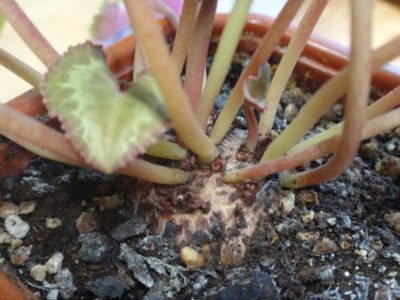

When a plant suffers from an excess of moisture, its leaves and flowers begin to fade. Signs of waterlogging are almost identical to signs of insufficient watering, so it is very easy to confuse the problem and try to save the flower by watering it abundantly, which will only aggravate the situation.
Signs that the plant has begun to deteriorate from excessive moisture:
- yellowness of the green mass;
- leaves can suddenly or gradually fly around;
- mold has appeared on the surface of the soil, the soil itself is damp and sour;
- softening of the stem;
- lack of leaf elasticity;
- shoots turn black.
What happens when a plant is waterlogged?
Excessive moisture in the soil is very dangerous for the cyclamen root system. In this case, the tuber begins to rot, over time the process of decay passes to the stem, peduncles and leaves. As a result, this leads to the complete death of the plant.
How to reanimate at home?
The main program of plant resuscitation is to improve care. In most cases, it is improper watering that becomes the root cause of cyclamen disease. The flower loves moisture very much, but waterlogging is destructive for it.... Water should not fall on the flower itself, you need to water it along the edge of the pots. Read how to save a flooded cyclamen here.
To keep the air around the plant moist, a tray with wet pebbles or peat is placed next to it. In the detailed instructions, we will tell you what to do if the plant disappears.
detailed instructions
- The first thing to do is transplant the plant. Carefully remove the tuber from the pot and inspect it for decay - the ability to revive the flower depends on how and how much the rot has spread. Found rotten parts, take a sharp knife and remove them until healthy tissue. So that when re-planting, these places do not rot again, they need to be processed. To do this, in 2 tbsp. l of water, dilute 1 drop of Prvikur and moisten the cut sites.
- After that, we transfer the tuber to a warm, dry, well-ventilated place and leave it for 24 hours in order to stop the decay process. After a day, you need to check the cyclamen, if there are wet spots on the tuber, then we leave it for another 24 hours.
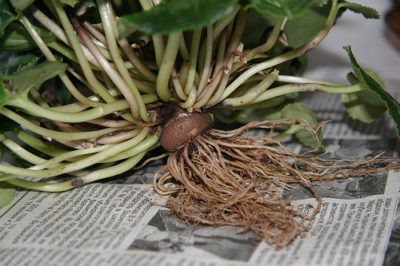

During this time, we prepare the soil - to carry out the disinfection process, for this you need to pour it into a special container and heat it well in the oven.- Some gardeners advise placing the soil in the freezer for 24 hours, but it is worth knowing that not all diseases can be ruled out in this way, for example, spores of parasitic fungi can withstand very low temperatures, while remaining viable.
- If the land is bought in a store, then there is no need to process it, since it goes through the disinfection process at the time of packaging. Before planting, the pot must be rinsed and rinsed with a solution of potassium permanganate.
- Plant the cyclamen, and put it in a dark place for 3 days, while watering should be very moderate.
- If during this time the green leaves did not begin to turn yellow - the processing of the tuber and the transplantation were carried out correctly, you can transfer the pot to the place familiar to the cyclamen.
You can remove any insects in the following ways:
- Insecticidal soap, which is dissolved in water at the rate of 50 grams per 4 liters of water. Soap solution is good for fighting mites and aphids. It is enough to take a cotton swab dipped in the solution and process the leaves of the plant from all sides.
- Fitoverm - this drug has proven itself well in the fight against many pests, its positive quality is the absence of an unpleasant odor and absolute safety for humans and pets. To treat a plant affected by a tick, an ampoule with a chemical is diluted with 0.5 liters of water. If thrips are started, you need to take 2 ampoules of 2 ml for the same amount of liquid. Spraying is carried out 2 times at intervals of a week.
- Argavertine - a universal preparation that destroys all insect pests. 1 ampoule is diluted with half a liter of water, the plant is sprayed. Usually one treatment is enough, but for prevention, you need to repeat the process after 2 days.
What should be done in this case?
First you need to pinch off yellowed and dried leaves at the base, as well as dry flowers. At the same time, you cannot use a knife or scissors, this can lead to further progression of cyclamen disease.
If heating devices are used in the room, then the plant is recommended to be moved away from them. Direct exposure to the scorching sun should also be avoided.... On hot days, you can put ice on the flower tubers. In the hot season, the alpine violet will feel much better in a shady corner. If it happened that the cyclamen stood in the sun for a long time, then you can put the pot in a basin with cold tap water for 1-1.5 hours. Thus, the flower can be revived.
Sometimes cyclamen begins to turn yellow and dry due to infection (read about the causes and treatment of cyclamen with yellowed leaves here). To get rid of the Fuzarium fungus, it is recommended to water the ground with a 0.1% solution of foundationol or spray the plant with a 0.1% solution of a drug such as Topsin-M.
Wet rot can also lead to wilting, and the plant smells foul. Bacteria enter through cracks in tubers... Quite often, infection occurs through the place of separation of the leaves. Sometimes infection can also occur through contaminated water or soil. A flower damaged by rot can be treated with an antiseptic, for example, crushed coal. In addition, the plant must be watered with settled water. In a situation where the infection was transmitted from another diseased plant, the cyclamen cannot be saved. All that remains is to destroy the flower.
Preventive measures
Cyclamen is a demanding and capricious plant that requires timely and high-quality care.
It's important to know:
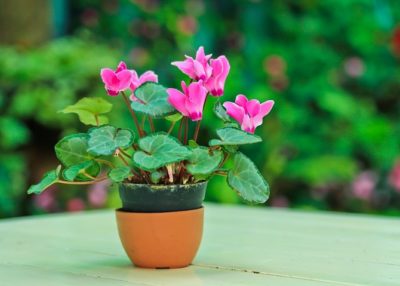

The temperature of the content should be - 12-15 degrees. A decrease in the indicator to +10 degrees is not allowed. Increasing to +20 is also detrimental to the plant.- Lighting - the plant is very light-requiring, but direct sunlight can cause irreparable damage to the cyclamen. If the window sill on which the planter with the plant stands is on the south side, then be sure to equip the shading.
- Proper watering - moisture should not get on the plant and its roots.
- Timely dressing, which needs to be applied only if the flowering of cyclamen is very fast. At the same time, compost is introduced into the soil in a proportion of 1:10 or 1 tbsp. l mineral fertilizer for flowering plants.
You can carry out preventive watering with weak solutions: Fundozol, Alirin B, Gamair or Fitosporin... These drugs will improve the condition of the flower, make its immune system strong, capable of fighting various diseases. Watering is carried out once a month.
What should be the care
As you can see, the most common reason that a flower wilted is a violation of the rules for caring for it. In order for the plant to be healthy and bloom beautifully, it must be looked after as follows:
- place the pot in the right place: on the east or west windowsill, avoiding direct sunlight;
- the temperature regime should be in the range of + 14-16 degrees. If the upper threshold is exceeded, the plant withers very quickly and dies;
- moderate watering is necessary. Water is poured in a thin stream along the sides of the pot. Remember, it is better to underfill the flowers than overflow. To avoid overflow, it is necessary to make an expanded clay drainage system at the bottom of the pot when transplanting. In such a situation, excess water will drain into the sump;
- watering is carried out only with well-settled water;
- humidity should also be moderate. To create it, you need to periodically humidify the air with a pultilizer. In this case, the plant itself cannot be sprayed, since if moisture gets on the leaves and tuber, they will begin to rot;
- mandatory application of fertilizers during the period of plant growth and the formation of inflorescences. It is not recommended to use fertilizers containing a lot of nitrogen. With such a diet, cyclamen becomes less resistant to various diseases.
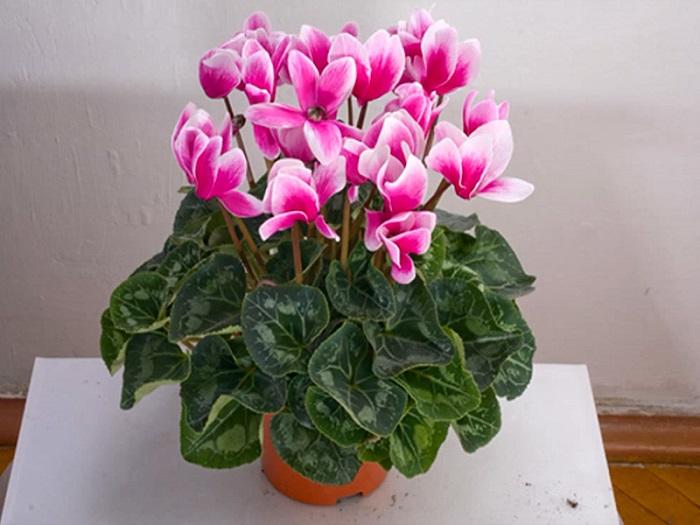

Every year, before flowering, the tuber should be transplanted into a slightly larger pot and with new soil, which should be nutrient-rich. Therefore, it is very important to choose the right soil.For cyclamens of all varieties, it is worth using a soil mixture of peat and leafy soil.
Separately, it should be noted that during the dormant period, which falls on the middle of summer, watering should be gradually reduced, and feeding should be completely stopped. If you follow the rules of care, then your pet will be healthy and strong, and the flowering will be violent and long-lasting.
The main causes of flower wilting
Disorders in care


Before we figure out how to reanimate cyclamen, let's outline the main causes of wilting. Failure to comply with the conditions of detention will definitely lead to the premature death of the flower:
- unbalanced temperature regime. Cyclamen will not bloom if the room is too hot. Withering can begin if you place the plant pot next to heating appliances;
- improper watering. This plant should never be flooded. If the soil turns into a swamp, the roots may rot. However, drought will also kill cyclamen. Watering is carried out about once a week, moistening the ground to the very bottom. Water for irrigation should be soft;
- direct sunlight. This flower loves diffused light. If a ray of the sun hits a delicate leaf, a burn may form there;
- lack of nutrients. Lean soil can also cause the plant to start dying.
Diseases and pests


Many gardeners are interested in the answer to the question of why a home cyclamen dies even if all the rules of care are followed. It is possible that the stem or leaves of the cyclamen were attacked by pests. It can be:
The presence of fungi is indicated by yellow leaves, which quickly begin to die, as well as gray bloom on the leaf plate. But if you find a wilted leaf, and a cobweb has appeared on its lower side, it means that a tick has wound up. The foliage affected by viruses is usually covered with spots at first, which crack, holes are formed.
Natural process


Home cyclamen develops cyclically. The plant blooms for a long time, and then goes into a state of dormancy. It is at this time that some leaves may turn yellow and dry, which must be removed by twisting. The flower should be placed in a cool place and practically not watered. Or you can dig out the tuber, peel it and store it until the beginning of autumn in a dry and ventilated room at a temperature not higher than +25 ° C. After planting, the cyclamen will delight you with a beautiful flowering in two months.
A plant can get sick if its living conditions have radically changed (transplant, for example). It is only required to remove the yellow foliage and carefully care for the flower until it recovers.
What is this flower?
ATTENTION: In specialized sources, this plant is called alpine violet because of its wide distribution in the Alps. The people often call the flower "pork bread" or "dryak". The homeland of cyclamen is the Mediterranean coast (countries of Southern Europe, Central Asia).
Among the features of the plant are rich green leathery foliage, a decorative silvery pattern on its surface, the original shape of flowers and petals in the form of a fringe. The color palette is extensive: from snow-white hybrids to burgundy flowers. The flowering period reaches 3 months. At home, cyclamen blooms in autumn or spring..
Useful video
We watch a video about cyclamen and a rest period:
If you find an error, please select a piece of text and press Ctrl + Enter.
If the leaves of the cyclamen turn yellow in the summer, then it goes to rest. What to do? How to store it? Oddly enough, but at the moment when most plants grow and develop intensively, the cyclamen begins a dormant period that lasts 2-3 months. So, the cyclamen is going to rest: what to do with the plant at rest, how long does the resting time last? What to do with cyclamen after rest?
As practice shows, cyclamen does not have a clear time frame for the rest period. The plant can delight with flowering throughout the spring and begin to shed its leaves closer to autumn. That is why the cyclamen cannot be sent to rest by force, that is, the buds and leaves from the tuber cannot be twisted. Nature itself will put everything in its place, and a grower is required to take normal care of the flower.
Fertilizer
Complex liquid fertilizers for ornamental flowering plants are suitable for cyclamens.
Top dressing is carried out during the growing season and flowering from October to April. Cyclamens respond well to liquid complex fertilizers for flowering plants. They are diluted with water in accordance with the instructions on the package, and then the flower is watered.
Top dressing for cyclamen should only be applied to wet soil
... It is not recommended to use foliar fertilizer as this can lead to an increase in leaf mass, which in turn will reduce the number of buds and flowers.
Prevention
In order not to think about how to save the cyclamen, you need to properly care for it and create a favorable habitat for it. Observe the moisture content of the soil and air. Protect the plant from direct sunlight. Be sure to ventilate the room, but avoid drafts. Do not forget: to revive a flower, it is enough to replant it at least once a year.
Prune old leaves. Examine the leaf plate for diseases and pests, and if found, immediately begin treatment.
Remember that cyclamen withers and does not bloom only when the rules of care and maintenance are not followed.
grow-
Video: CYCLAMEN (Suslamen). Surprises ?! Or what to expect from homemade seeds
If the leaves begin to turn yellow or become stained, or rot at the edges, and his flowers are healthy and strong, most likely the matter is in the general humidity of the room, which the cyclamen is sorely lacking. Dry air is also undesirable for this plant. Usually, a pallet with expanded clay is placed next to the flower, which saturates the air around the plant with moisture.
If the leaves show that they are twisted or deformed, covered with spots or wet sticky dew, then most likely your flower is attacked by pests. In this case, you can purchase special products in the store, with which you can then process the leaves or stems (depending on what is damaged by the parasites). Some drugs also dissolve in water and are sprayed from a spray bottle to the affected areas and, without purposefully moving away, to the plant itself as a prophylaxis. In any case, if you determine in time what is wrong with your plant and immediately start treatment, the chances that you will save it from death are quite high.
Help what to do? The cyclamen is fading! Nothing helps!
The reason for the yellowing of the leaves is high temperature, insufficient watering and bright sun. Waterlogging of the soil and water ingress on the upper part of the tuber can cause rotting. Irregular feeding during the growing period and during flowering, high temperature and improper watering is the reason for the short flowering period. Thrips, aphids and mites cause deformation of leaves and flowers. It is necessary to regularly and carefully inspect the plants, especially in winter, and fight against the detected diseases and pests. By steaming the soil before planting, you will get rid of harmful organisms. It is necessary to spill it with a pink solution of potassium permanganate. Plants should not be fed fertilizers with an increased concentration of nitrogen, as this makes cyclamens susceptible to infections. If gray or root rot, fusarium wilting appears, it is necessary to treat cyclamens with systemic fungicides or biofungicides (Fitosporin-M, Trichodermin or others). If root rot appears on an adult plant, you can try to save it. Remove from the pot, rinse the roots and remove the damaged ones.Then treat with fungicide and plant in a steamed earthy mixture. Good luck!
Doesn't it coexist with ficus plants? They can be very bad influence. Or move away from the battery, on a cool north window, and place on a tray of water for moisture. Just do not sprinkle the leaves!
need a north window. This is a very moody plant. Little water dries, a lot of water dies
to bury and forget will still in life cyclamens and amaryllis
If the cyclamen withers, you need to think carefully about the exact reason. Maybe it was going to rest - a period of rest begins. In this case, the leaves will wither, and the tuber is going to have a good rest. Maybe watering is not enough - after all, cyclamen drinks a lot of water! Maybe - on the contrary, there is too much water, and the soil in the pot is acidic. My cyclamen also wilted badly, a lot of buds died. As it turned out, there was almost no soil in the pot, its entire mass was filled with roots. I transplanted, I water it so that there is always a little water in the pan. And the plant came to life. The buds, however, have dried up, but new, beautiful leaves are growing. I think that it will bloom. Here are some simple tips for growing cyclamen indoors: North and east windows are preferred, and southern plants need shading. The soil is a mixture of leafy earth, sand and loam in a ratio of 2: 1: 1. The tuber is partially buried if the roots are located on its lower side, or completely if they cover the entire tuber, as in European and ivy-leaved cyclamens. Water regularly when the plants begin to grow, add fertilizer during flowering, and almost stop watering when the leaves begin to wilt and the plant is about to dormancy. Only young specimens with small tubers that can dry out need rare watering and during dormancy. It is not recommended to pour water on them directly on the tuber - this can cause rotting of the growing point, and then the whole plant. The flowering time of potted cyclamens depends on the conditions of maintenance (watering regime, lighting, temperature), but, in general, falls on the cold season — from autumn to spring. Although the European cyclamen can bloom in summer.
if you bought a Dutch plant, it is his fate that has faded away and that's it. They themselves tried to revive, nothing came of it
Growing problems
Homemade cyclamen, as well as many indoor flowers, can be sore. Most often, this plant affects anthracnose, fusarium, wet rot and sooty fungus.
- Fusarium is a fungal disease, its pathogens live in the ground. Therefore, the defeat of cyclamen with this disease begins with the root system. If the leaves turn yellow on one side, and the plant blooms poorly, this is a sure sign that the flower is affected by Fusarium. Treatment of fusarium wilting is carried out with the help of one percent concentration of foundationol. The root system of the plant is poured with a solution. In combination with such measures, the aerial part of the flower is sprayed with Topsin-M of the same concentration.
- When affected by wet rot, the leaves of the cyclamen become lethargic, and the tuber gives off an unpleasant rotten smell. After a while, the tubers begin to rot, and the bacteria spread to the leaves, stems and flowers. Flowers that are sick with wet rot, unfortunately, cannot be cured, so they must be destroyed.
- Anthracnose is a disease that develops during the flowering of cyclamen. The ideal conditions for the development of the disease are high indoor temperatures and high air humidity. First, the disease affects the peduncles, which dry out in a short time, then it turns into leaves, which turn yellow, curl and dry out. Cyclamens suffering from anthracnose are treated repeatedly with a fungicide solution. All affected parts on the plant are removed.
- As a rule, sooty fungus appears on flowers where aphids previously lived. Ailing flowers develop poorly, weaken. The leaves turn yellow and dry out. Treatment methods: remove plaque with a damp cloth.A soapy solution is used to treat the aerial part of the flower.
When growing cyclamen at home, many growers are faced with problems such as lack of flowering and yellowing of foliage.
Cyclamen leaves turn yellow for several reasons - dry air in the room, high temperature conditions, irregular watering. Very often, the leaves of flowers that are in direct sunlight turn yellow. This is a consequence of sunburn.
Helping prepare for hibernation
Going to rest, the "sleeping flower" stops forming flower buds, but young leaves can still grow for some time. This is due to the fact that the tuber needs to store nutrients for the next waking period.
The tuber actively stores "food" for the future flowers and therefore cracks may appear on it. If the soil is allowed to dry out, especially more than once, their appearance greatly increases.
Such cracks will not do much harm to the cyclamen if you do not immediately fill them with abundant water. Getting into cracks, water promotes rotting of the tuber, and the plant will tolerate dormancy much worse.
It is possible to fight the decay of cracks. It is enough just to cover them with ash or crushed coal. After such treatment, the wounds will heal with a crust after a few days.
Dying, yellowing leaves and drying flowers are carefully removed. This should be done by removing along with peduncles and leaf stalks, to the very surface of the tuber. Cyclamens rarely throw off the leaves completely. Gradually reduce watering and transfer the plant to its place.
Should I be forcibly sent to the plant in such a state?
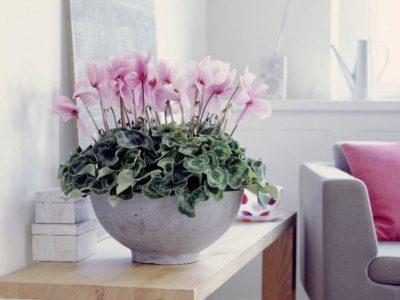

There is a false opinion that if the time of year for a cyclamen is time to rest, but he does not want to and continues to bloom, it is necessary to force him to do it. Cutting off the leaves and twisting the flower buds - you will not do better for your pet. Cyclamens forcibly sent to rest get sick and may even die.
In the case when the plant itself is not yet ready to retire, it cannot be forcibly “put to sleep”! Cyclamen should be helped and protected from direct sunlight. Put it in the shade for now, gradually the plant will go to rest by itself.
An interesting fact is that young cyclamens may not "go into hibernation" at all. They continue to "stay awake" and bloom all year round. Over time, their regime will return to normal.
How to save cyclamen: diseases and pests
Fungal diseases: prevent by regular potting, spill the soil with an available fungicide, use disinfected fresh soil when replanting. As soon as you notice the whitened areas - remove with a treated knife, use a fungicide.
Viral diseases: remove damaged areas until they have spread, and in case of mass defeat, exterminate the flower.
Pests: often ticks settle on the cyclamen at home, because of which the leaves turn yellow. You can quickly cope with the help of available insecticides. Treat and remove damaged areas. The procedure is lengthy, often tedious, but you can save it.
↓ Write in the comments what problem you encountered on the cyclamen and what else would you like to know about caring for a flower?
Trim / Support / Garter
Throughout flowering, wilted and starting to dry flowers are required to maintain a decorative appearance. At the onset of the dormant period of the plant, when all the leaves have turned yellow and dry, they must be carefully cut off at the tuber level. No special pruning of cyclamen is required.
During flowering, wilted flower stalks and yellowed leaves are best removed by twisting.
This method is good in that the peduncle or leaf is completely removed without damaging the tuber. When pruning, a small stump remains near the tuber itself, which, if moisture gets on it, can begin to rot.
Cyclamens rot very easily, so it is advisable not to leave their parts for the propagation of the infection when removing peduncles and leaves.
After the end of flowering, removing the leaves and forcibly creating a dormant period for the plant is not required. Many varietal plants do not have a pronounced dormant period. Therefore, you just need to gradually remove withering and drying leaves, without touching the rest.
Temperature
Cyclamen is very picky about air temperature.
During the growing season and flowering (for the Persian cyclamen, this is the period from early September to late May), you need to maintain a cool temperature in the room. It should be at least 10 ° С at night and not higher than 15 ° С during the day.
At temperatures above 18 ° C, its cyclamen bloom stops
and the plant gradually goes into a dormant state.
During the dormant period from the beginning of June to the end of August, you should also not increase the temperature too much, as this can lead to the death of the plant.
Do you need to transplant cyclamen into a large pot?
Usually the question arises with a seasonal transplant of cyclamen - replace the old pot with a larger one once every one and a half to two years, but you are going to move the cyclamen, so why not take the pot at the same time. In this case, one must proceed from considerations that the cyclamen was flooded, the tuber was damaged, weakened. What happens if you plant a larger pot? The plant will again receive a lot of moisture. You can use a pot literally 2-3 cm larger, but not 5-10, as in the case of a seasonal transplant.
Let's remember how to change the pot according to the standards: once every 1.5-2 years, 8-10 cm more for an adult, 5 cm more for a young one, once a year.
Phased transplant of flooded cyclamen:
- Remove the cyclamen from the pot. Remove wet clods of earth, examine the root processes. Trim if you see rotten parts.
- Treating with a fungicide is a mandatory procedure so as not to rot.
- Place drainage * on the bottom of a new pot, and earth on top.
- Move the cyclamen, sprinkle with earth around the edges.
- Do not completely immerse - 1/3 above the surface.
* In addition to the drainage layer, a pot with drainage holes is used, which helps to get rid of excess moisture and prevents the cyclamen from rotting when over-watering.
The transplanted cyclamen is placed in a moderately warm place. and introduce measured, restorative care for a month. Water sparingly, adding a fungicide to the water from time to time. How many times a week to water the cyclamen? Drain the excess from the pallet, dry almost halfway before re-moistening.
↓ Write in the comments, what do you do if you fill in the cyclamen?
Please rate the material you have read
What to do if the cyclamen wilted
Cyclamen is a perennial, herbaceous plant. Its root is a tuber.
Many inexperienced growers are afraid to acquire this compact, long and luxuriantly blooming, bright plant. They believe that the home flower cyclamen withers under any unfavorable conditions, is very moody and unpredictable. But this is not the case. With proper care, all types of cyclamens feel great in our apartments and bloom for a long time.
The indoor flower cyclamen is a very compact and unusual plant. Its original flowers look like butterflies, they seem to be circling above the leaves in some kind of magical dance. And of course, seeing a blooming cyclamen in the store in winter, we stop in surprise. And, not finding the strength to part with this miracle, we buy it. When choosing a blooming cyclamen in a store, we carefully examine the leaves so that they are strong and do not sag. If the root is on the surface of the plant, we are considering whether there is mold, we try to choose a non-shriveled specimen with young leaves. By the way, it is better to choose plants on which there are still many unblown buds.
How to proceed?
So, how can you save a flooded cyclamen and what to do if you overwet the plant too much? The success of measures to save cyclamen is determined by the degree of rotting of the tuber.
- If there is a little rotted part, there is a chance of recovery. An urgent transplant is required:
- Prepare a pot with a hole in the bottom, as well as drainage and soil. The soil can be purchased at a specialized store or prepared by yourself. A breathable coarse peat substrate is required. For the soil mixture, leafy earth, humus, peat and sand should be combined in equal proportions.
On a note. If there is no new soil, you can use the old one. First, make sure that it does not smell like rot or mold, and dry it. - Disinfect soil and pot if not new. Bake the substrate in an oven preheated to 80 degrees for 30 minutes.
- Remove the flooded plant from the pot.
- Carefully loosen soil residues from the roots.
- Examine them.
- If the roots are firm and elastic, the overflow of the plant has not yet led to irreversible consequences.
- Place the plant on pre-spread newspapers.
- Blot the root system, let it dry.
- Pour a drainage layer 5 centimeters into the bottom of the pot. You can use expanded clay, clay shards, tiny foam plastic, coal, vermiculite.
- Place fresh, slightly moistened soil on the drain so that after transplanting one third of the tuber is above the surface.
- To stimulate, slightly powder the root system with root.
- Plant the plant in the center of the pot and add a little substrate. In the summertime, place expanded clay on the surface of the soil to prevent overheating.
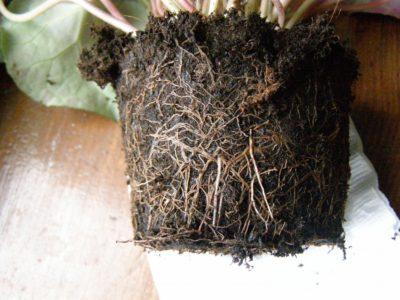

If some of the roots have become soft, brown, the process of root decay has already begun. To save the cyclamen you need:- Flush the root system.
- Trim rotten roots with scissors or a sharp knife to healthy, dense tissue.
- Dry the root system.
- Sprinkle the cut with crushed activated carbon.
- Plant the plant in fresh or dried soil.
- Then proceed as described above.
- If all the roots are soft, brown, it will not be possible to save the plant. You can cut cuttings, process them with root roots and try to root them in a greenhouse, for example, under a plastic bottle.
- If the tuber is rotten:
- The decayed part should be cut out to a healthy place.
- Dry slightly, treat with activated carbon powder.
- Plant in fresh cyclamen soil. The tuber should be half above ground level and the roots should not curl upward.
Note! Do not place a flooded plant in the sun - its roots will mate.
You can learn more about how to reanimate cyclamen at home here.




